Blogs
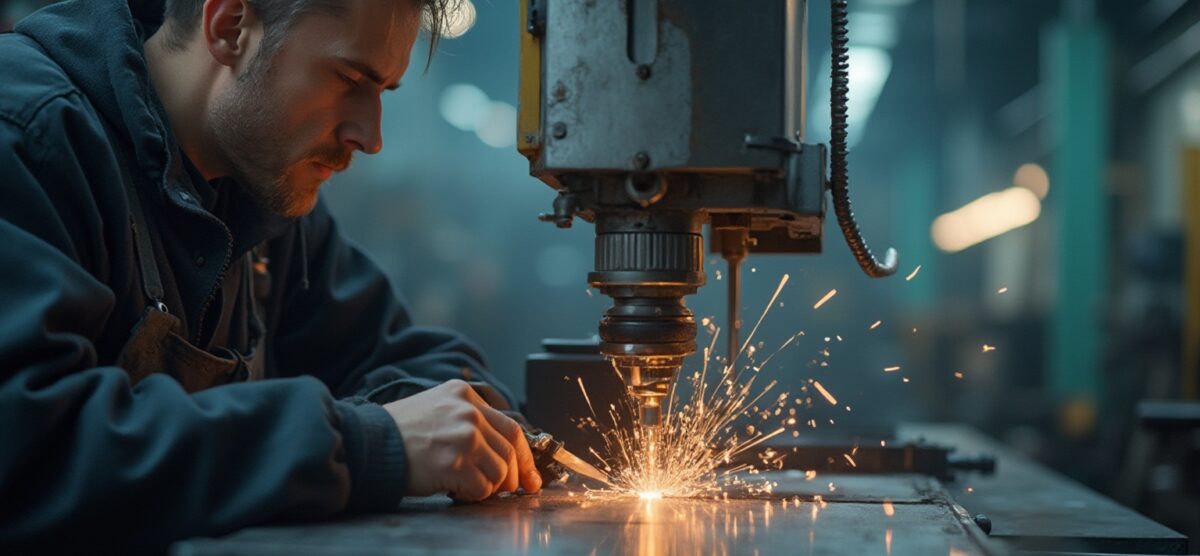
How to Master Machining Copper Beryllium: A Step-by-Step Guide
Overview:
The article focuses on mastering the machining of copper beryllium, emphasizing essential techniques, safety precautions, and innovations that enhance processing efficiency and product quality. It supports this by detailing specific methods such as instrument selection, cutting speeds, and the use of coolants, while also addressing safety measures necessary to mitigate health risks associated with beryllium exposure, thereby ensuring effective and safe machining practices.
Introduction
Beryllium copper stands out as a formidable alloy, prized for its unique combination of strength, electrical conductivity, and resistance to corrosion. As industries increasingly rely on this versatile material, understanding its properties and applications becomes essential for procurement managers and engineers alike. From aerospace components enduring high stress to non-sparking tools that enhance safety in explosive environments, beryllium copper’s role is pivotal across various sectors.
However, the challenges associated with machining this alloy, particularly its toxicity, require a strategic approach to ensure both efficiency and safety. This article delves into the intricacies of beryllium copper, exploring effective machining techniques, safety precautions, and innovative solutions that empower professionals to optimize their operations while safeguarding their workforce.
Understanding Beryllium Copper: Properties and Applications
Beryllium copper is a remarkable alloy known for its exceptional strength, impressive electrical conductivity, and corrosion resistance, making it a preferred option in various industrial uses. Complying with international standards such as UNS and ASTM, DOMADIA Beryllium Copper is engineered for safety and performance. This alloy generally comprises between 0.15% to 0.5% of a specific element and demonstrates a low elongation percentage of 7 to 17%, greatly improving its hardness and fatigue resistance—traits essential for rigorous uses.
In the aerospace sector, for instance, its robustness is crucial for components subjected to high stress and operational demands. Furthermore, the unique properties of this copper alloy position it as an ideal material for electrical connectors, where reliable conductivity is paramount. Key uses of copper alloy include:
- Oil rig parts
- Mining implements
- Fasteners
- Essential non-sparking devices designed for explosive environments
These non-sparking instruments are essential alternatives in explosion-prone settings, ensuring safety and compliance with stringent material standards. However, it is essential to consider the toxicity of beryllium; inhalation of beryllium dust can lead to chronic beryllium disease, classified as a Group 1 human carcinogen. Comprehending these characteristics and safety considerations is essential for the effective machining copper beryllium, as they directly affect the choice of processing methods and equipment.
Given its high strength, specific cutting implements are necessary to reduce wear and uphold accuracy during processing operations. This knowledge not only aids in optimizing production efficiency but also ensures the longevity and performance of the finished products.
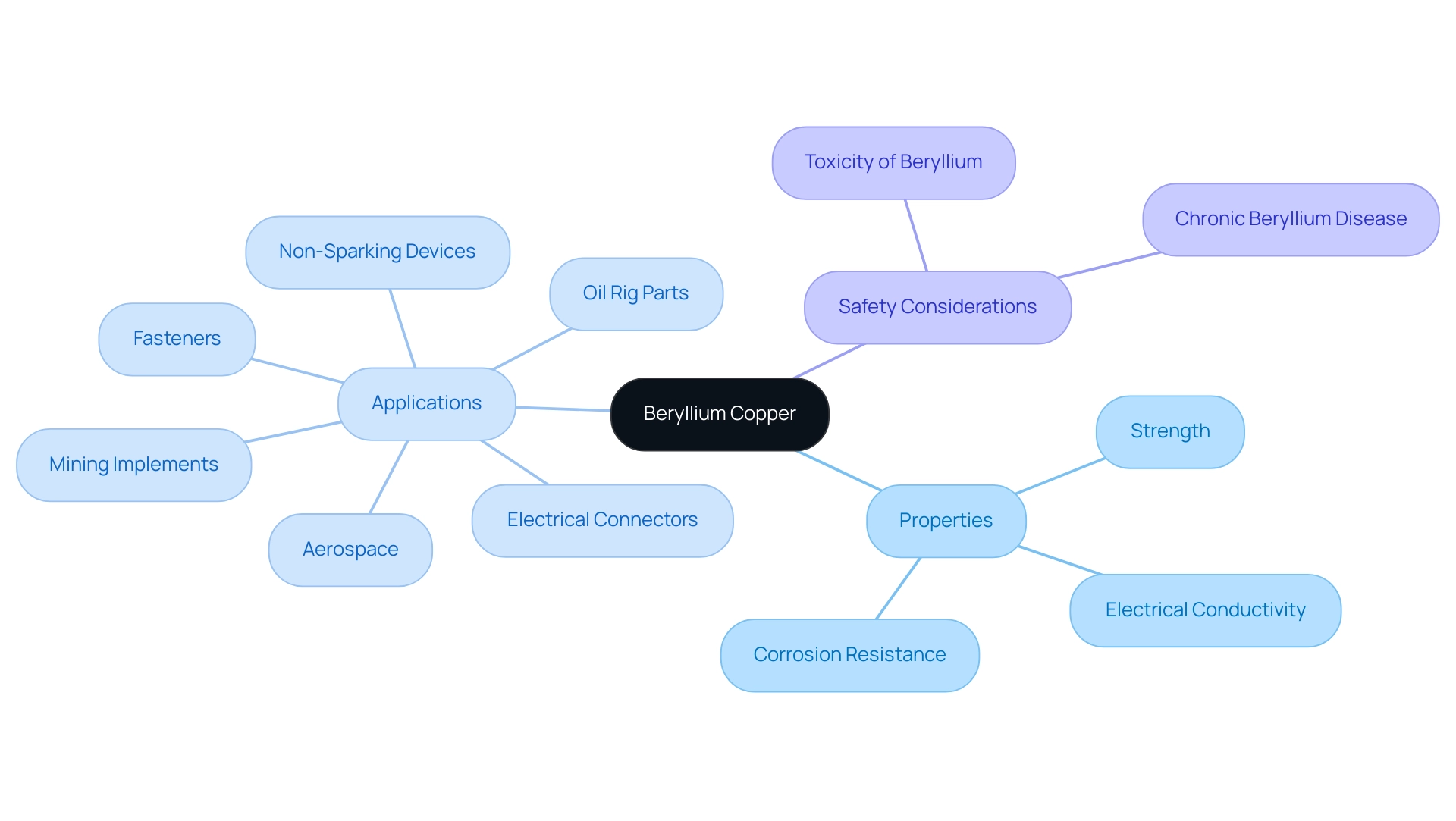
Techniques for Effective Beryllium Copper Machining
To achieve optimal processing of Beryllium Copper, several key techniques should be employed, reflecting Domadia’s commitment to providing high-quality solutions and exceptional customer service:
- Instrument Selection: It is essential to use carbide or ceramic implements with sharp edges to minimize wear and enhance performance. The selection of material is vital, as it directly influences machining efficiency and the durability of the cutting instruments, aligning with Domadia’s extensive product range designed for various uses, including foils, sheets, rods, and wires.
- Cutting Speed: Maintaining a moderate cutting speed is vital for balancing efficient material removal with tool longevity. Speeds generally vary from 100 to 200 feet per minute, demonstrated to be effective in numerous industrial uses while maintaining the integrity of the tools.
- Coolant Use: The application of flood coolant is recommended to dissipate heat and improve surface finish. This not only helps in attaining a lower surface roughness—reportedly as fine as 2 nm, and up to 8 nm—but also significantly decreases equipment wear, thereby enhancing overall performance, which is crucial for projects requiring precise specifications.
- Feed Rate: Adjusting the feed rate based on the tool type and specific cutting conditions is crucial. Generally, a slower feed rate yields superior results, allowing for better control over the machining process and improved finish quality.
- Machining Operations: Prioritizing operations such as milling, turning, and drilling is essential. It is important to ensure that the right parameters are established for machining copper beryllium, which is known for its strength, conductivity, and corrosion resistance, to maximize efficiency and effectiveness in production—an essential aspect of Domadia’s innovative manufacturing practices.
In recent insights, Joseph Crim from Brush Wellman noted,
Aluminum-beryllium containing 62 percent beryllium has an elastic modulus almost three times that of aluminum 6061 T6 and weighs about 25 percent less, but costs only about half what pure beryllium costs.
This highlights the potential of aluminum-beryllium alloys as cost-effective alternatives in applications requiring specific properties. These alloys not only provide improved machinability but also deliver considerable cost savings, highlighting the importance of knowledgeable equipment selection and processing methods to utilize these benefits.
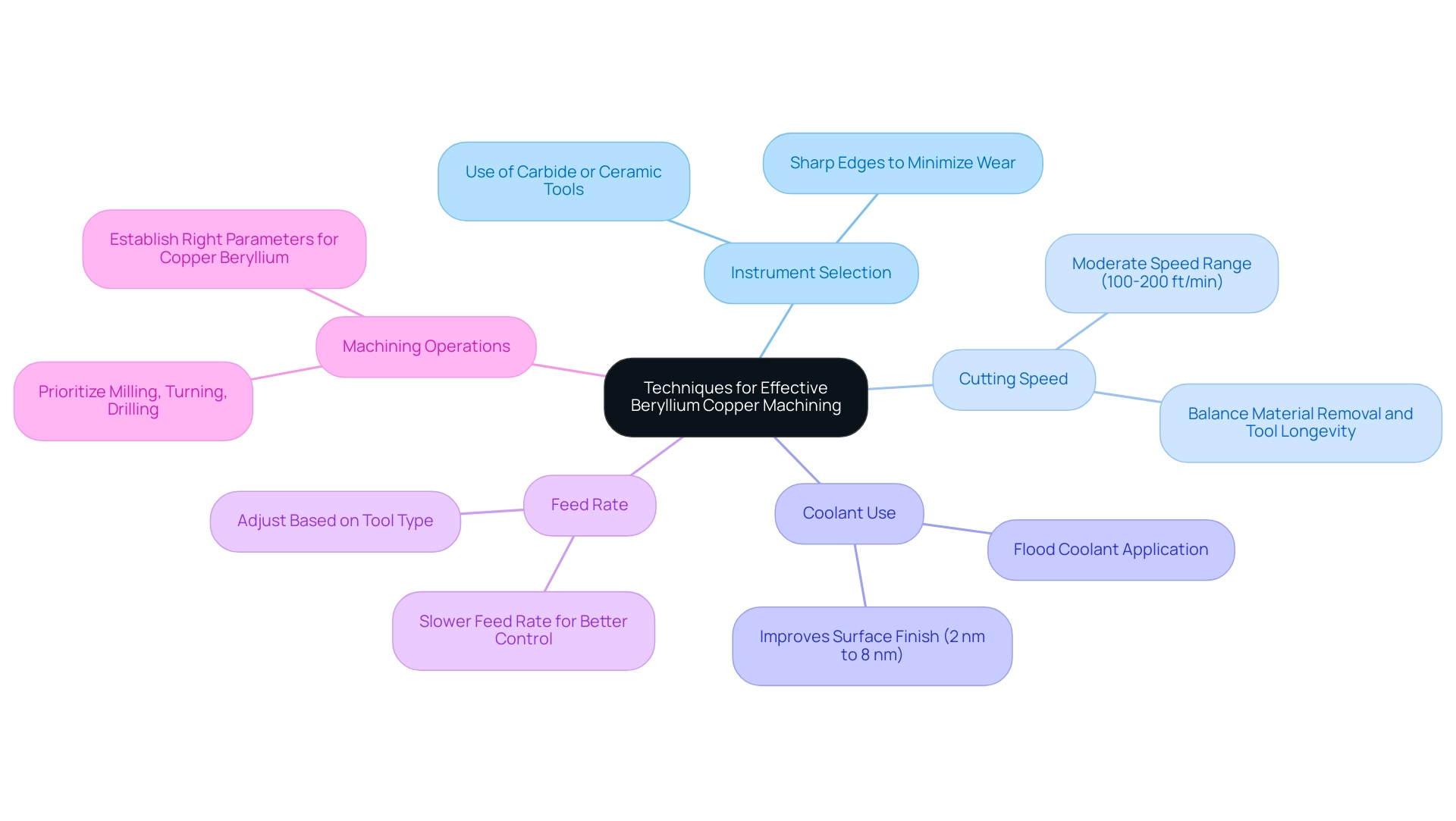
Safety Precautions in Beryllium Copper Machining
When machining copper beryllium, especially when utilizing tools such as the Non-Sparking Wrench, it is vital to enforce thorough safety measures to reduce health hazards linked to exposure. Here are key measures to observe:
Personal Protective Equipment (PPE): Utilize appropriate PPE at all times, including gloves, goggles, and respiratory protection, to safeguard against harmful dust. The effectiveness of PPE in metal processing environments is paramount, as it serves as the first line of defense against harmful exposure.
Ventilation: Ensure that the work area is equipped with adequate ventilation systems. Adequate airflow is crucial to lessen airborne particles, thereby decreasing the risk of inhalation.
Dust Control: Implement effective dust collection systems designed to capture particles generated during machining operations. These systems are essential in ensuring a safe workspace by reducing airborne levels of the element.
Training: Comprehensive training programs should be established for all personnel to educate them on the hazards associated with this substance, along with proper handling techniques. This training fosters a culture of safety and awareness within the workplace.
Health Monitoring: Regular health monitoring of workers exposed to this substance is critical for the early detection of potential health issues. As OSHA states, “CBD is a progressive illness with a continuous spectrum of symptoms ranging from its earliest asymptomatic stage following sensitization through to full-blown CBD and death.” This highlights the importance of proactive health assessments for safeguarding worker well-being.
Moreover, a case study by Joseph et al. (2001) demonstrated the connection between exposure to a specific element and altered gene expression, revealing consistent differences in the expression of cancer-related genes. This highlights the importance of strict safety protocols in metalworking settings.
Additionally, statistics show that while the SMR for lung cancer deaths in a specific cohort was not statistically significant, the presence of 18 lung cancer deaths emphasizes the potential risks involved.
By adhering to these precautions, especially when machining copper beryllium with non-sparking implements like the Beryllium Copper Non-Sparking Wrench, businesses can ensure compliance with current safety regulations and protect their workforce from the health risks associated with beryllium exposure.
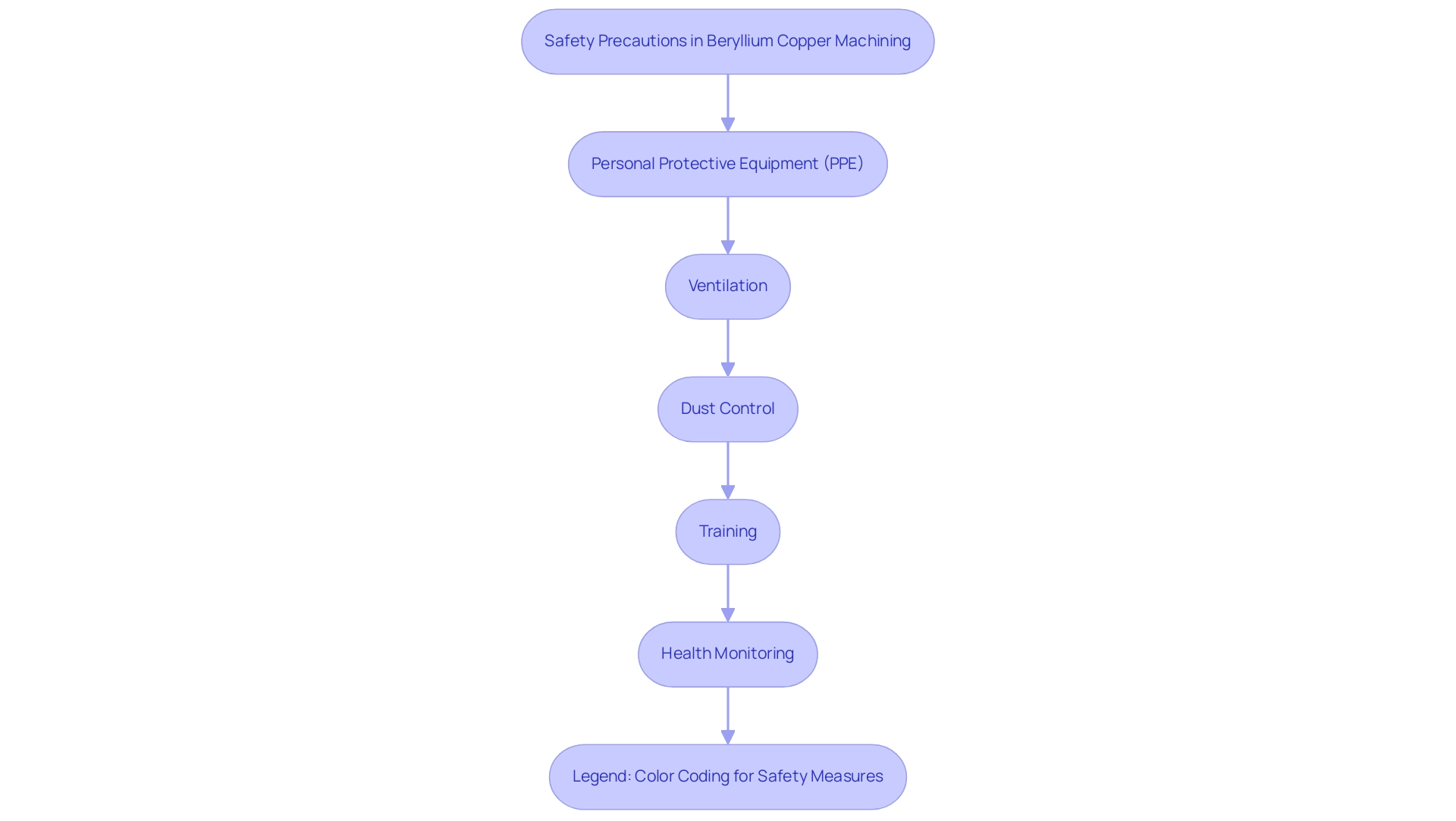
Troubleshooting Common Machining Challenges
The challenges of machining copper beryllium require careful consideration and strategic adjustments. At Domadia, your trusted partner for Beryllium Copper solutions, we understand the importance of addressing these issues effectively. Our extensive product range includes foils, sheets, rods, and wires, all customizable to meet your specific needs.
Below are the most common challenges encountered, along with recommended solutions:
- Equipment wear is a prevalent issue in machining copper beryllium. To mitigate this, consider modifying the cutting speed and feed rate or opting for more durable material for the instruments.
As emphasized by Andresa Baptista in her research on wear behavior in milling processes of AMPCO alloys, addressing the wear mechanisms in machining copper beryllium alloys is essential for prolonging the lifespan of cutting instruments.
Poor Surface Finish: Achieving a satisfactory surface finish can be challenging. Ensure that the appropriate coolant is utilized and that processing parameters are meticulously optimized.
The right coolant not only aids in heat dissipation but also enhances the overall quality of the machined surface.
Chip Formation: Incorrect chip formation can lead to operational inefficiencies. If chips are not forming correctly, examine the geometry of the device and make necessary adjustments to the feed rate.
Proper chip removal is crucial to preventing equipment blockage and ensuring smooth processing operations.
- Vibration: Excessive vibration during machining can adversely affect precision and equipment performance. To counteract this, verify that the workpiece is securely clamped and that the cutting implement is aligned correctly.
Proper alignment decreases the chances of vibrations that can result in surface defects and equipment wear. Overheating is a prevalent issue that can harm both the equipment and the workpiece. If overheating is observed, increase coolant flow and reduce cutting speed to better manage heat generation.
Efficient cooling is essential for preserving equipment integrity and guaranteeing ideal processing conditions. Regular maintenance and proper customization of implements for machining copper beryllium are essential for their longevity. This includes routine cleaning, thorough inspections, and avoiding harsh chemicals that could compromise their integrity.
In ongoing research, it has been noted that pulse on time contributes significantly (91%) to material removal rate (MRR), underscoring the importance of optimizing cutting parameters for improved efficiency. Additionally, the study of ultrasonic vibration-assisted diamond cutting of 3C-SiC demonstrates innovative solutions that can be applied to enhance machining performance. At Domadia, we stay dedicated to offering extensive Beryllium Copper solutions, ensuring that you have the resources and support essential to tackle these challenges effectively.
Our non-sparking equipment is particularly valuable in explosive environments, providing safety without compromising on performance.

Innovations in Beryllium Copper Machining Techniques
Recent advancements in machining copper beryllium are transforming the sector, particularly in enhancing efficiency, accuracy, and sustainability, with a major emphasis on applications in non-sparking implements for explosive settings. Key advancements include:
Advanced Cutting Instruments: The introduction of coated carbide implements has greatly enhanced durability and lowered friction, facilitating extended lifespan and more effective processing operations.
These instruments are especially efficient for machining copper beryllium, which is recognized for its toughness and durability, rendering them perfect for non-sparking uses.Automation: The integration of CNC processes has transformed traditional practices, enhancing precision and minimizing human error. Automated systems ensure consistent quality and increased production rates, which is crucial in industries where accuracy is paramount, such as semiconductor manufacturing and electronics.
Non-sparking tools made from machining copper beryllium, including the non-sparking beryllium copper wrench, are essential in these settings to mitigate risk.Additive Manufacturing: Innovative additive techniques are now being explored to create complex geometries that conventional manufacturing methods cannot achieve. This capability enables intricate designs while minimizing material waste, particularly advantageous for high-performance uses requiring non-sparking tools.
Smart Machining Systems: The use of IoT technology allows real-time observation of processing parameters, aiding the dynamic enhancement of procedures. By leveraging data analytics, manufacturers can make informed adjustments to improve efficiency and reduce downtime, vital for producing reliable non-sparking tools.
Sustainable Practices: The adoption of eco-friendly coolants and recycling processes is crucial in machining operations.
These advancements reduce environmental impact and conform to industry benchmarks for sustainability, improving corporate responsibility.
A significant use of copper alloy, especially in machining copper beryllium, is in the implementation of alloy targets for thin film deposition in semiconductor production and electronics. These targets are essential for creating advanced materials required for contemporary technological uses, further illustrating the material’s importance in high-tech sectors.
Industry leaders stress the necessity for quality assurance in manufacturing non-sparking implements, with certifications like ISO 9001:2015 and AS9100:2016 guaranteeing thorough inspection processes. In Europe, especially in Germany and the U.K., the market for copper alloy processing represents about 25%, highlighting the material’s significance in the worldwide market.
As mentioned by Tae Jo Ko,
HF-EDAM based on copper-alloy bundle electrodes could modify the electrode surface shape in real time and adapt the surface to be processed due to its unique flexibility and wear resistance.
This innovation not only boosts the efficiency of machining copper beryllium but also emphasizes the continuous dedication to refining techniques, ensuring that copper remains an essential material in advanced technological uses and non-sparking tool manufacturing. For more insights, check our latest blog updates on beryllium copper applications.
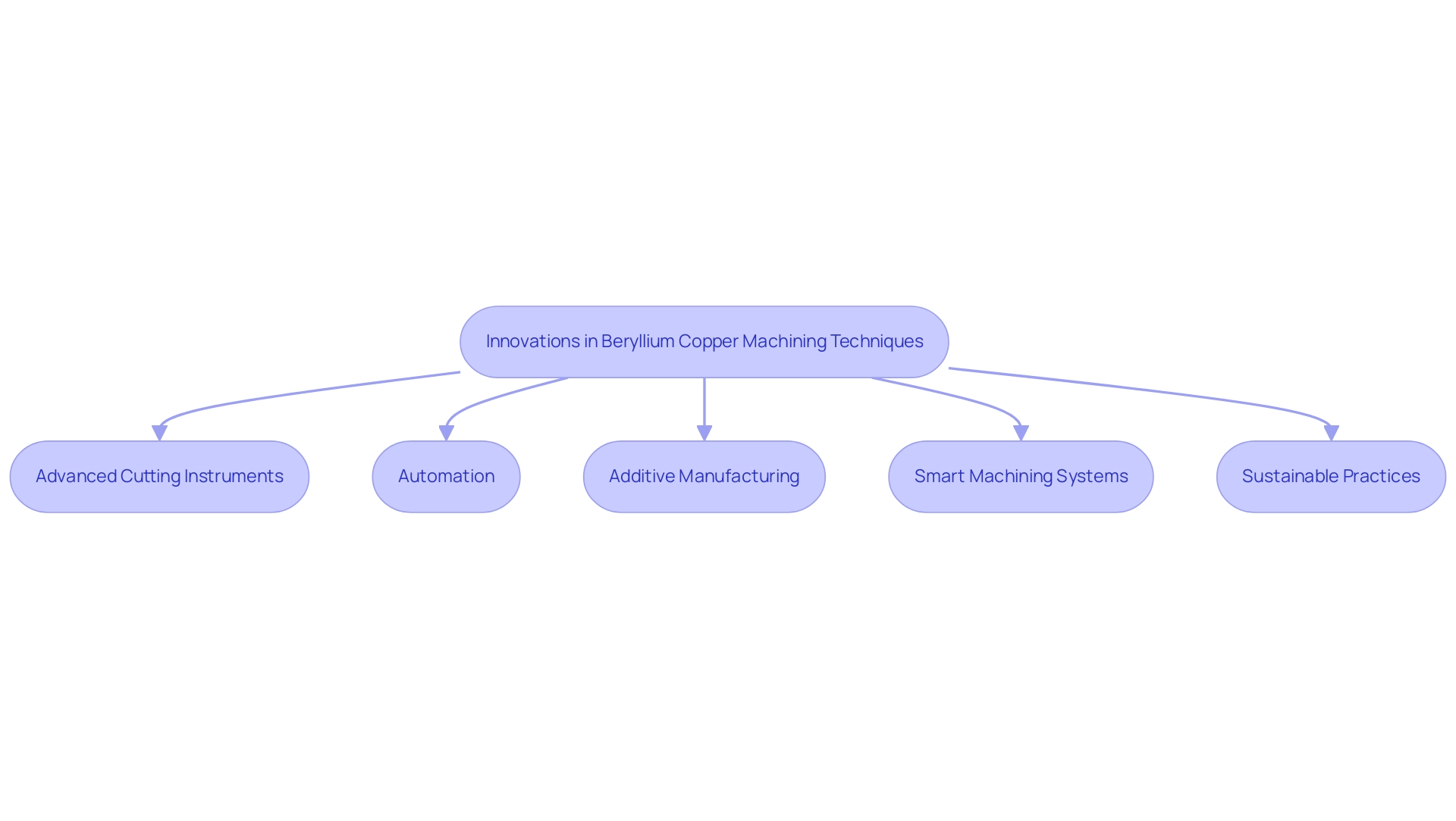
Conclusion
Beryllium copper has established itself as an indispensable alloy across a multitude of industries due to its exceptional properties, including strength, electrical conductivity, and corrosion resistance. From aerospace components to non-sparking tools, its applications are diverse and critical, emphasizing the need for a thorough understanding of its characteristics and machining requirements. The strategic selection of tools, optimal machining parameters, and adherence to safety protocols are paramount in maximizing efficiency while minimizing health risks associated with beryllium exposure.
In addressing the complexities of machining beryllium copper, it is essential to implement effective strategies that tackle common challenges such as:
- Tool wear
- Surface finish quality
- Overheating
By utilizing advanced techniques, including the use of modern cutting tools and automation, professionals can enhance precision and productivity, ensuring that operations meet the rigorous demands of today’s industrial landscape. Furthermore, embracing innovations in machining practices not only improves operational efficiency but also aligns with sustainability goals, reinforcing the importance of responsible manufacturing.
Ultimately, a comprehensive approach to beryllium copper machining—characterized by informed tool selection, effective safety measures, and continuous innovation—will empower industries to harness the full potential of this remarkable alloy. As the demand for high-performance materials grows, understanding and optimizing the unique properties and machining techniques of beryllium copper will be crucial in maintaining a competitive edge while safeguarding the health and safety of the workforce.




